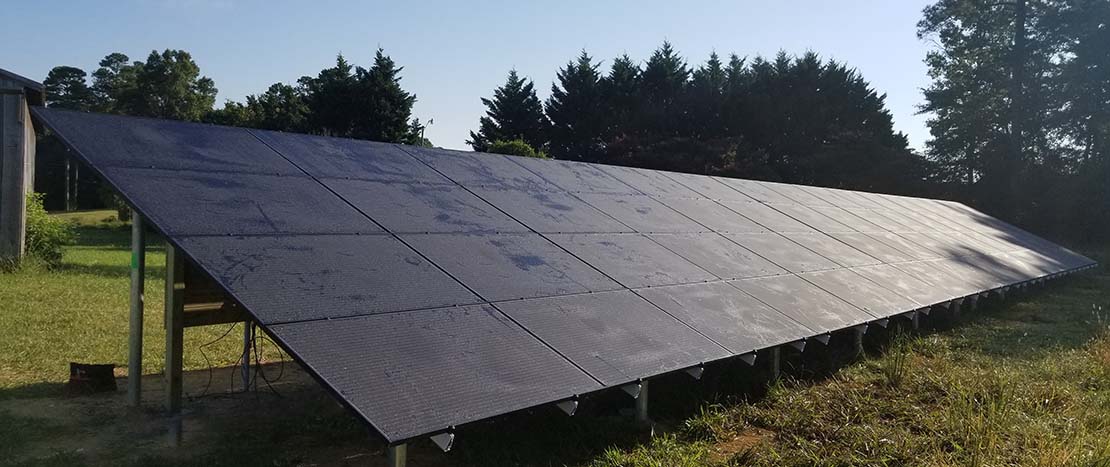A ground-mount solar system can be a more efficient alternative to roof-top residential solar panels, but it is not the perfect solution for everyone. A ground-mount solar installation typically includes a metal frame anchored into the ground in a variety of ways. The design and structure must pass safety approvals before installation and pass an inspection after installation. Another type of ground-mount solar installation is a pole-mounted solar system. The key difference is the height of the system.
Just like with roof-top solar, we can install a battery backup system with either a ground or pole-mounted system.
Let’s look at the pros and cons of having a ground-mount solar system.
- Pro: Optimal Solar Panel Orientation
In a typical roof-top solar installation, you have to take what the original builder gave you. For example, ideally, we want to point panels straight south and at a 38 to 40-degree pitch/angle. Unfortunately, you can’t change the orientation of your roof.Roofs often have protrusions such as a chimney, ventilation pipe, attic fans, etc. Not only can these protrusions restrict where and how many solar panels you can install, but they can also cast a shadow on neighboring solar panels.Roofs are also a fixed size. If your roof isn’t large enough, you may not cover your whole bill. - Pro: Easy Solar Panel Maintenance
When on the ground, solar panels are easily accessible. While solar panels are generally maintenance-free, when there is a need, it is far easier to work with the solar panels at ground level.There are less important maintenance tasks that would not be worth the effort on the roof, but would be easy at ground level. For example, while the snow melts quicker on solar panels, you still have to wait for the snow to melt to gain access to the sun’s power. With a ground mount system, you can easily and safely clear off the snow. - Pro: No Roof Hassles
We always try to line up a solar system’s life with a roof. For example, if a roof has five or fewer years left, we strongly recommend re-doing the roof first so you don’t have to remove and reinstall it shortly after solar installation. There may be additional tax incentives if you include your roof as part of your solar project (consult your tax professional). While we do offer a solar panel removal and reinstallation service, if that’s an expense you can avoid, then avoid it. - Pro: Other Uses
Depending on the local rules (each county in Southern Maryland has different rules for ground-mount solar systems), you may use the area under the solar panels for storage or shade.
All the pros are fine, but let’s look at some cons.
- Con: You Need Space
Most homes don’t have the space needed for a ground-mount system. It’s not just the footprint of the system, but you also need an area sufficiently clear to avoid shading the system. Because the solar panels are closer to the ground, they may be susceptible to more tree shade. For example, a 10-foot tall tree next to a two-story home does not affect the roof, but that same tree on the south side of a ground mount system would affect solar production. - Con: Cost (typically, but not always)
There are cases where solar on the ground is less expensive than on the roof, but that is mostly in situations where the roof has extremely shady conditions and the ground mount system is close to the house and main service panel (breaker box). The increased efficiency often means that you will need fewer solar panels on the ground to achieve the same solar production on the roof.While a ground-mount system is almost always more efficient, that efficiency usually comes at a cost. Generally, the further the ground solar array is from the main service panel, the higher the costs. More digging, more pipe, and more wire increase cost, but when the distances get above about 250 feet, we also need to upgrade the wire to maintain energy quality.We also have the cost of building the structure to hold the panels, whereas, with a roof, the structure is mostly in place.
Conclusion
Bottom line is, that a ground-mount solar panel system can be a great alternative in the right situation. Often we see higher upfront costs offset by higher lifetime savings because the efficiency outweighs the cost. Of course, every project is unique. We’re happy to work with you on different scenarios to compare. We regularly design standalone ground-mount solar systems, but we will also frequently show hybrid options where we split the system between the roof and ground.


